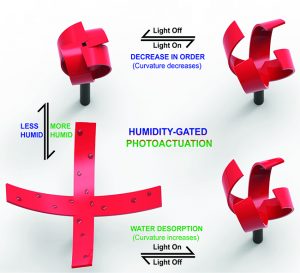Nature has always been a great source of inspiration for scientist working across different fields. Countless natural systems are able to adapt and respond to multiple contemporary stimuli such as changes in temperature, light, humidity, etc.
In plants, such behavior is greatly pronounced, allowing them to adapt and respond to environmental changes. When specific environmental conditions are met, some plants can also undergo dramatic shape changes triggering complex process such as blooming and bearing fruit.
The ability of natural systems to adapt to different environments is due to a complex interplay of forces which is still extremely challenging to reproduce in artificial actuators. However, thanks to the efforts of many researchers, preliminary actuators that are sensitive to their environment, have been recently demonstrated. Unfortunately, they still either lack precise control over shape changes or rely on stimuli that are orthogonal and not interdependent.
In their paper recently published in Advanced Materials, Prof. Arri Priimägi’s group from University of Tampere and Prof. Albert P.H.J. Schenning’s group from University of Eindhoven present an artificial actuator made from monolithic liquid crystal polymer networks that are able to mimic the behavior of nocturnal flowers, “blossoming” when certain light and humidity conditions are met.
The “humidity-gated photoactuation” has been achieved by combining photothermal azobenzene derivatives and hydrogen-bonded acrylates. As a result, the “nocturnal actuator” based on this hydrogel, closes under day conditions i.e., when the humidity level is low, and the light intensity is high, whereas it opens under dark and humid conditions, corresponding to night-time.
The reported actuation approach combines many features relevant for realizing multi-responsive/adaptive biomimetic devices. Firstly, it is responsive to temperature, light and humidity. Secondly, being liquid crystal based it has an excellent control over directionality, and shape change can be pre-programmed into the monolithic piece of polymer. Finally, it responds to the delicate interplay existing between light and humidity and consequently adapts its shape.
this research will certainly inspire the development of new multi-responsive materials with increasing complexity and soft-robotic systems adaptive to the environmental changes. The interplay between the stimuli also paves way towards the development of simple logical functions into actuating systems.

















